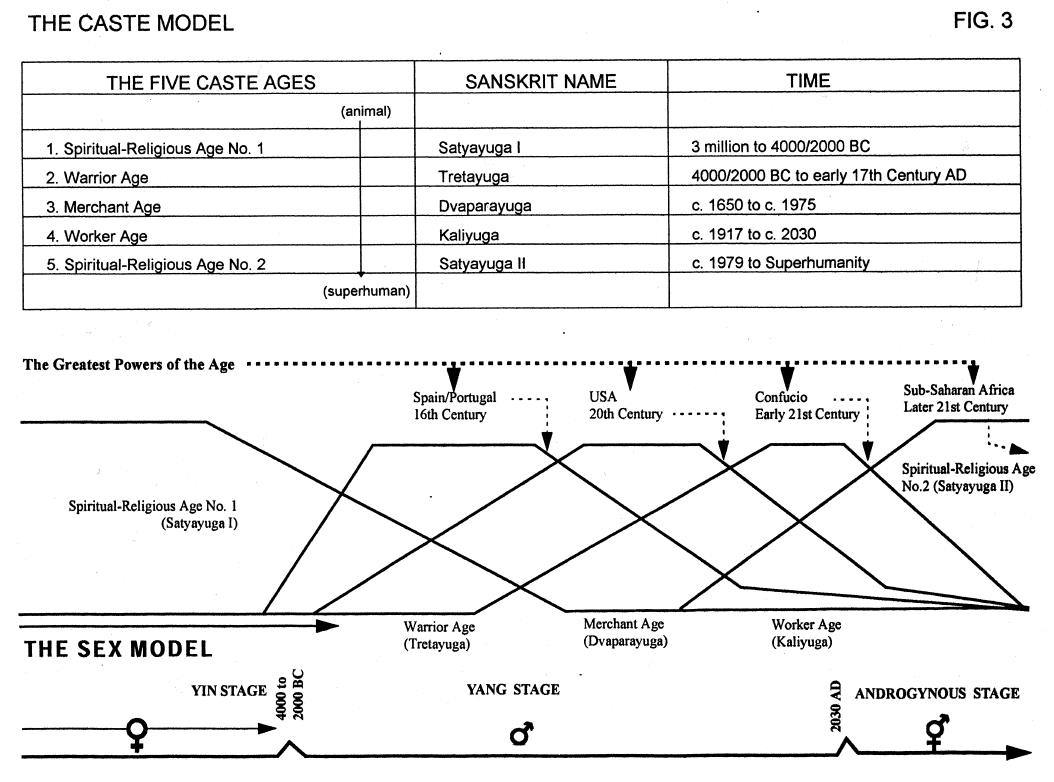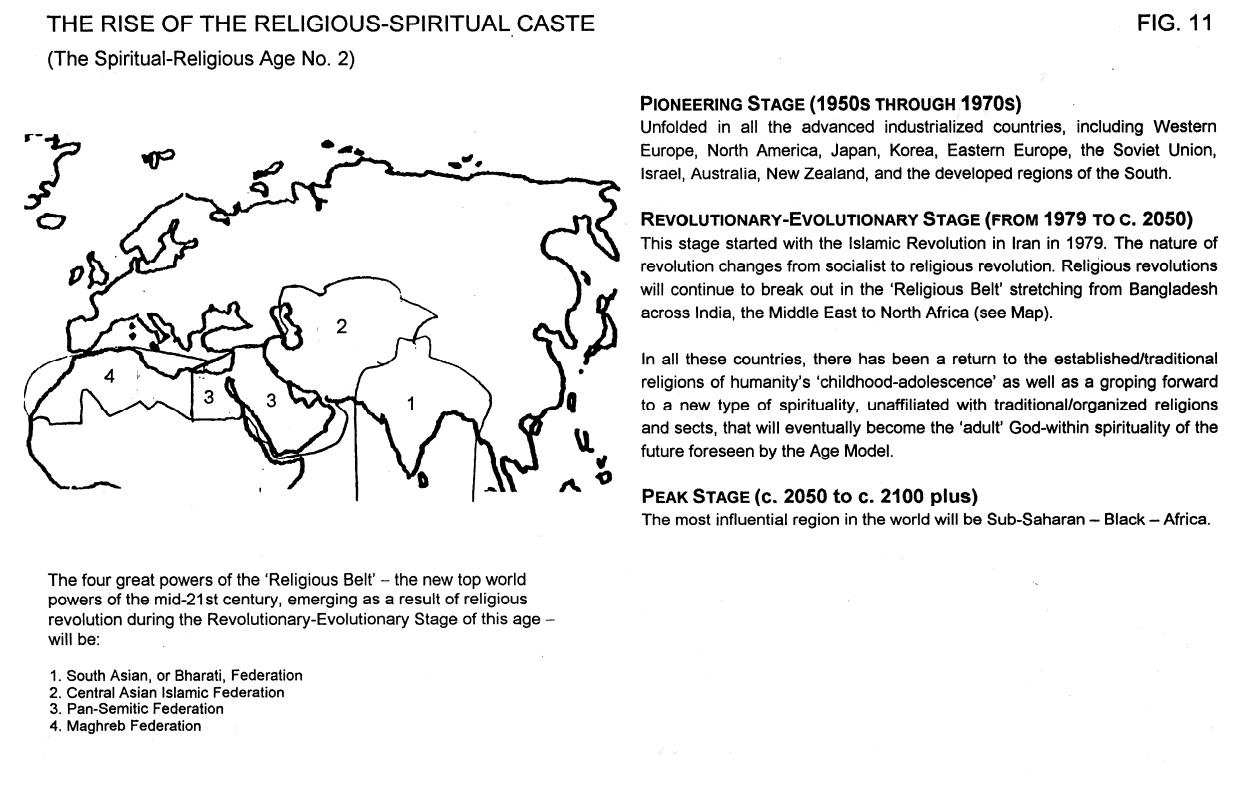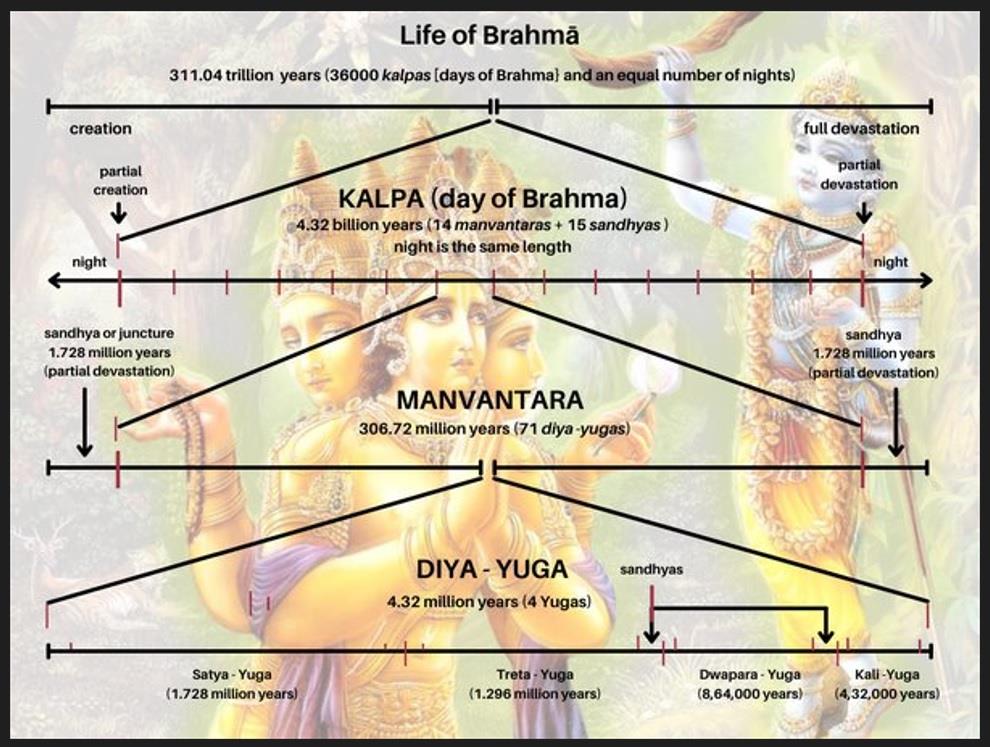(MENAFN- Asia Times) In the 1980s, the American futurist Lawrence Taub developed a macro-history based on Hindu cosmology that shows a path to the end of the notorious caste system. His book The Spiritual Imperative Sex, Age, and the Last Caste maps actual linear history to the Varna cycle that forms the basis of Vedic cosmology, the root of the caste system.
The Indian (Hindu) worldview is personified by Brahma, the creator of the universe. Ancient Vedic sages predicted that humanity would go through four distinct socio-economic stages before attaining proverbial peace on Earth. This prophecy has parallels with the prediction of the second coming in Abrahamic religions.
According to the Vedas, the life of Brahma lasts 311.04 trillion years. One day in the life of Brahma is one kalpa, or 4.32 billion years. The smallest unit in Brahma's life is the yuga, which lasts a little over a million years.
Humanity partakes in Brahma's life in this universe only for a brief period. The astronomical numbers used in the Vedas suggest that the sages viewed the current universe as one in a series of endless Big Bangs.
The cycle of the four yugas started with the Satya Yuga, an age“ruled” by the Brahmans. The Hindu epic Mahabharata depicts the Satya Yuga as a time of bliss on Earth.
“There were no poor and no rich; there was no need to labor because all that men required was obtained by the power of will; the chief virtue was the abandonment of all worldly desires.
“The Satya Yuga was without disease; there was no lessening with the years; there was no hatred or vanity, or evil thought; no sorrow, no fear. All mankind could attain supreme blessedness.”
The Satya Yuga was followed by three other ages: the Treta Yuga ruled by the Kshatriya (Warriors), the Dvapar Yuga ruled by the Vaishya (Merchants), and the Kali Yuga, ruled by the Sudra (Workers).
The Brahmans, Warriors, Merchants, and Workers, are known as Varna. The four types probably were conceived after the age of the hunter-gatherer and the development of agriculture and human settlements.

The cycle of the four Varna.
The formation of the first towns led to a division of labor, and the sages identified four basic traits or generic types. They concluded that people have a certain worldview, inclination, and aptitude that fit into four categories they called Varna.
The Varna are generic types rather than strict categories. A person can have the worldview and inclination of a Merchant, but can also have a Warrior impulse. A Warrior can also have a Merchant or Brahman inclination.
But one of the four Varna types typically predominates in every individual. It is the“cosmic imprint” – or dharma – that permeates everything that exists.
Dharma means natural propensity, function, or property. The dharma of fire is to burn, that of water is to flow, and that of air is to be invisible. The Warrior's dharma is to fight and protect his people. Dharma is the twin of karma.
Dharma is the“duty” an individual is called to fulfill by the cosmic imprint, and karma is the extent to which people abide by their dharma.
The Varna prophecy was originally a cycle of four social types that were believed to be indispensable for society to develop. In later years, political leaders corrupted the Varna idea and turned it into a class system that would have horrified the ancient Vedic sages.
The Caste Model
In the mid-1970s, Lawrence Taub traveled to northeastern India to study at the ashram of Ānanda Mārga, a spiritual and social service organization founded by the Indian spiritual teacher Prabhat Ranjan Sarkar. It offers socio-spiritual teachings and practices for individual emancipation, collective welfare, and the fulfillment of physical, mental, and spiritual needs.
While at the ashram, Taub attended a lecture on Sarkar's Progressive Utilization Theory (PROUT), a blueprint for a cooperative and decentralized economic theory based on socio-ideological concepts from the West and the ancient Vedic worldview, including the Varna cycle.
Initially, Taub dismissed the Varna prophesy as mere myth-making that permeated the Vedic classics. However, after his stay in India, he continued his travels and arrived in Japan, where he had an epiphany. He saw evidence in history that the Varna cycle plays out in actual history.

Taub defined the four Varna in contemporary terms.
Taub redefined the four Varna types in contemporary terms. He identified Merchants as entrepreneurs, bankers, industrialists and financiers, while Workers were defined as those working for a wage, whether they were factory workers, bureaucrats or managers.
Taub next mapped the Varna cycle to actual history, both in time and space – specific years and specific regions. The West dominated the Merchant Age because its worldview was most closely aligned with the Merchant Varna type, and East Asia will dominate the current Worker Age for the same reason; its worldview is closely aligned with the Worker Varna type.
Taub identified several Varna transitions. Spain was the last great power of the Warrior Age. Holland, home of the world's first stock market, was the first power of the Merchant Age. It was superseded by England, which in turn was overtaken by the United States, the last great power of the Merchant Age.

Taub mapped the Varna cycle to actual history.
In Taub's Caste Model, each Varna stage brings about positive and negative changes. The Warrior Age perfected the art of war, but Warrior Age kings like Constantine and Ashoka also spread spiritual consciousness through religions such as Christianity and Buddhism.
Similarly, the Merchant Age saw colonial exploitation but also launched the scientific revolution and shifted humanity's focus from the next life to this world. The Worker Age was hyper-materialistic but also developed solidarity, the first age to demand basic human needs for all people, including food, housing, education, and medical care.
Overlapping Varna
Taub's model describes the rise of a new Varna in three steps: the Pioneering Stage, the Revolutionary-Evolutionary Stage, and the Peak Stage.
In his model, the world is now nearing the Peak Stage of the Worker Age. But remnants of the previous Merchant Age still linger: excessive wealth concentration, environmental destruction, and a tendency to prioritize profit over people.
The Worker Age has yet to reach its peak, but the next Varna has already made its presence felt. It started in the second half of the 20th century, when a growing number of people started to reject the hyper-materialism that characterizes the Worker Age.
It led to the emergence of the hippie movement, New Age, and a growing interest in Eastern spiritual practices like yoga and meditation.

Taub's map of the next Satya Yuga.
Taub's Caste Model explains a seemingly contradictory trend: the simultaneous emergence of consciousness-raising movements such as the hippie movement and New Age, and the rise of fundamentalism in Islam, Christianity, Buddhism and Hinduism. In Taub's model, these trends are all part of the early stage of the next Varna Age, the Satya Yuga.
Taub published his book after a series of lectures in Tokyo during the 1980s. The book did not attract much attention in the West, but a Japanese translation reached the No 1 spot on that country's best-seller list. It was followed by a Korean and a Spanish translation.
Takuya Murata, a Japanese scholar who reviewed Taub's book for Futures magazine in 2007, recognized that Taub's model shed light on the contradictory developments in the world today – secularity and religious fundamentalism. Murata wrote:
Murata continued:
The end of work
In Taub's model, the Merchant Age lasted about 300 years, from the 16th to the early 20th century. The current Worker Caste Age will last less than a century, from the early 20th century to about 2050. The Worker Age will provide most of humanity with basic material needs, but it will lead to the end of (most) work. The only work that will remain is work that requires human care and empathy.
The Fourth Industrial Revolution now being shaped in China will see the deployment of artificial intelligence (AI), robotics, the Internet of Things (IoT), and other forms of hyper-automation. The next Varna stage, the Satya Yuga, will be marked by a shift in values and worldviews.
“By 2050, or somewhat later,” Taub writes,“machines and the energy to run them (mostly light and solar) will be so sophisticated that human and machine will be integrated. With basic needs met, economic activity will cease to be the center of human life.
“Due to the general trend of the new age toward religion and spirituality, economic activity – and related worker-caste activities such as science, technology, and materialism – will lose its centrality in any case.”
Taub predicts the“spiritualization” of economic life by several movements: voluntary simplicity, appropriate technology, the end of poverty, and the end of (most) work. These movements require a complete reorganization of the current system, which Taub believes is beyond the capabilities of the current Worker Age.
“Our current Worker Age,” Taub writes,“is an age of both great spiritual and material development. But it is also the Kali Yuga, the most socially alienated, materialistic, spiritually dark and dismal, complicated, disorienting, and dangerous of all caste ages. It is, in short, the best and worst of all possible worlds so far.”
As we move out of the Kali Yuga and into the Satya Yuga, people have to adjust mentally to life without work. In the Worker Age, our identities and social status are closely linked to our job, profession, or skill, be it engineer, doctor, or accountant.
AI will diminish the value of professional knowledge, but it will give people more time for social, spiritual, and leisure pursuits.
In the“Post-Fourth Industrial Revolution,” it will no longer be important what you know but what you are. According to Taub, the currency of the new Satya Yuga will be self-knowledge rather than knowledge.
There will be no more workers, merchants, and warriors. There will only be teachers and students, and the Caste System will become history.
Like this:Like Loading...



























Comments
No comment